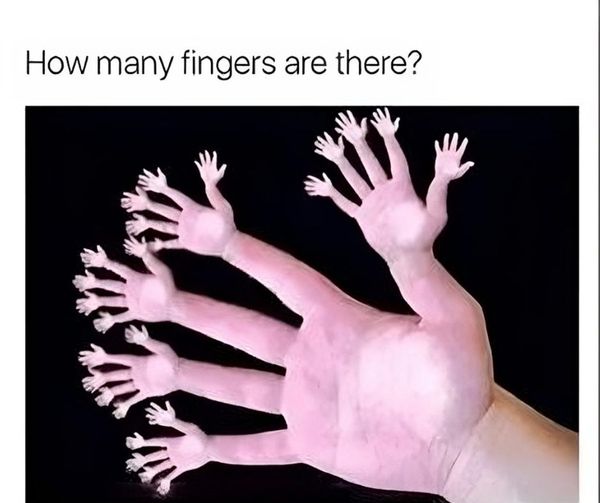In the ever-evolving world of social media, it’s no surprise that the latest brain-teasing optical illusion has taken the internet by storm. Originating from the popular Instagram account @unseenillusions, this mind-bending puzzle has sparked intense debate and left users scratching their heads, all while trying to determine the correct answer.

What Makes This Optical Illusion So Special?
Optical illusions are nothing new, but every so often, one comes along that leaves even the sharpest minds stumped. This latest illusion is a prime example of how our brains can be tricked into seeing something that isn’t quite there—or, in this case, counting something that seems impossible.
The Puzzle: How Many Fingers Are There?
The illusion in question features a hand, but with a twist—each finger is connected to another hand, which is then connected to yet another hand. The challenge? Determining the total number of fingers present in this intricate visual puzzle.
The Debate Begins
As the post has amassed over 400 comments, the responses have been varied and diverse. Some believe the correct answer is 155 fingers, while others have opted to exclude the thumbs, bringing the total down to 150. However, other guesses have ranged from 130 to 160, 175, and even a staggering 215 fingers.
User Reactions: A Mixed Bag
One user jokingly commented, “More than they should be,” highlighting the sheer complexity and mind-bending nature of this optical illusion. Another added, “I am not counting all of those,” echoing the sentiment of many who have been overwhelmed by the task.
The Correct Answer Revealed
After carefully analyzing the image and considering the various responses, the correct answer is 155 fingers. This solution comes from the careful counting of 31 hands, each with 5 fingers, resulting in the total of 155 fingers.
Why Is This Puzzle So Difficult to Solve?
Solving this kind of visual puzzle requires a sharp mind and keen analytical thinking skills. Your ability to accurately determine the correct answer indicates a high level of cognitive capability, demonstrating your prowess in perceiving and processing complex information.
The Science Behind Optical Illusions
Optical illusions like this one exploit the brain’s tendency to fill in gaps and make sense of chaotic information. When faced with a pattern that seems impossible, our minds often struggle to reconcile the visual input with logical reasoning.
A Mental Workout
Engaging with such puzzles isn’t just fun—it’s also a great way to exercise your brain. Solving optical illusions can enhance cognitive functions such as memory, problem-solving, and spatial reasoning.
Can You Solve It? Give It a Try!
Now, let’s get interactive. Do you have your own answer to this perplexing optical illusion? I’d love to hear your thoughts and insights. Were you able to accurately count the fingers, or did you find yourself stumped, like many others who have encountered this challenge?
Join the Conversation
Engaging the reader through a conversational tone and rhetorical questions helps to create a more personalized and relatable experience. By inviting the reader to share their own perspectives, we can foster a sense of community and encourage active participation in the discussion.
An Analogy to Simplify the Puzzle
To further enhance the reader’s understanding, let’s explore an analogy. Imagine a tangled web of hands, each finger intricately connected to another, creating a puzzle that challenges our perception of reality. Much like unraveling a complex knot, solving this optical illusion requires a methodical approach and a keen eye for detail.
A Lesson in Perception
While the topic at hand may be intricate, it’s important to maintain clarity and concision in our writing. By keeping the language simple and easy to follow, we can ensure that the reader remains engaged and able to grasp the key concepts without becoming overwhelmed.
The Broader Impact of Optical Illusions
Optical illusions are more than just fun—they’re a window into how our brains work. They reveal the complexities of our cognitive processes and challenge our understanding of reality.
Why Do These Illusions Go Viral?
The viral nature of optical illusions is rooted in their ability to engage people on a deep level. They create a shared experience where everyone can participate, debate, and challenge their perception, making them perfect for social media.
The Takeaway: Celebrate Your Brain’s Power
In conclusion, this viral optical illusion has once again demonstrated the remarkable versatility and complexity of the human mind. By challenging our perception of reality and pushing the boundaries of our cognitive abilities, it has sparked a global conversation and highlighted the importance of analytical thinking and problem-solving skills.
Final Thoughts: Did You Solve It?
Whether you were able to solve the puzzle or not, the mere act of engaging with this brain-teasing challenge is a testament to the power of the human mind. As we continue to explore the world of optical illusions and visual puzzles, let us embrace the opportunity to expand our understanding and celebrate the remarkable capabilities of the human intellect.





